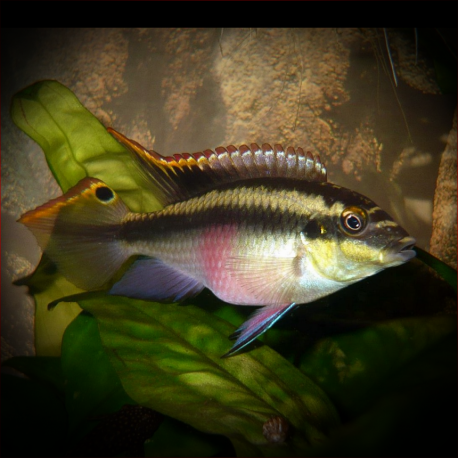More info
Datasheet
| Minimum Tank Size | 71 litres / 18.76 US gallons |
| Maximum Size | 10.0cm / 3.94inches |
| Temperature | 24°C / 75.20°F - 27°C / 80.60°F |
| Hardness | 0-12ºdH |
| pH | 5.0-7.5 |
General Description
The Kribensis, scientifically known as Pelvicachromis Pulcher, is a popular cichlid species within the aquarium hobby. This fish, commonly referred to as "Krib," is well-suited for beginner cichlid enthusiasts due to its manageable size, ease of care, and captivating breeding behaviors. It is often found in a striking albino form and has been a beloved choice among fishkeepers since its introduction in the 1950s. In the wild, Kribensis are native to Nigeria and Cameroon.
Aquarium Setup
For optimal care, a tank size of at least 71 liters is recommended. The tank should be furnished with ample hiding spots like clay pots, caves, roots, and driftwood. While plants are not mandatory, they provide enrichment and cover for the fish. A substrate of sand or fine gravel is preferred as Kribensis tend to excavate pits for breeding. Water parameters should range from a pH of 5.0-7.5, a hardness of 0-12°dH, and a temperature between 24-27°C. Detailed water condition requirements are summarized in the provided table.
Behaviour
Kribensis are generally peaceful and suitable for community tanks, but they can become territorial, especially during breeding. They should not be housed with large or vigorous species. Compatible tankmates include small characins, barbs, danios, rasboras, Corydoras, gouramis, and Loricariids. When kept with other cichlids, such as West African Dwarves, sufficient space must be provided for territory establishment. It is advisable to keep Kribensis in pairs, with larger tanks needed if multiple pairs are to be housed together.
Feeding and Diet
The Kribensis is an omnivorous species that readily accepts various foods. A high-quality cichlid pellet can serve as a staple diet, supplemented with live and frozen foods to ensure a balanced nutrition. Regular feedings of live and frozen foods help simulate their natural diet and enhance their overall health.
Reproduction & Dimorphism
Breeding Kribensis is relatively easy, as they are known to be cave spawners. They form monogamous pairs and typically breed in community tanks. It is recommended to obtain a pair by purchasing a group of 6 or more young fish and allowing natural pairing to occur. Males are larger and develop pointed dorsal, caudal, and anal fins, while females exhibit a purple belly when in spawning condition. Successful breeding requires specific tank conditions, detailed diet preparations, and sufficient hiding spots for spawning.
Habitat and Distribution
In their natural habitat, P. pulcher inhabits still and slow-moving waters, often densely vegetated and shallow. Some populations can tolerate brackish conditions. These fish are commonly found in Nigeria and Cameroon, demonstrating adaptability to varying water chemistry parameters prevalent in their native environments.

